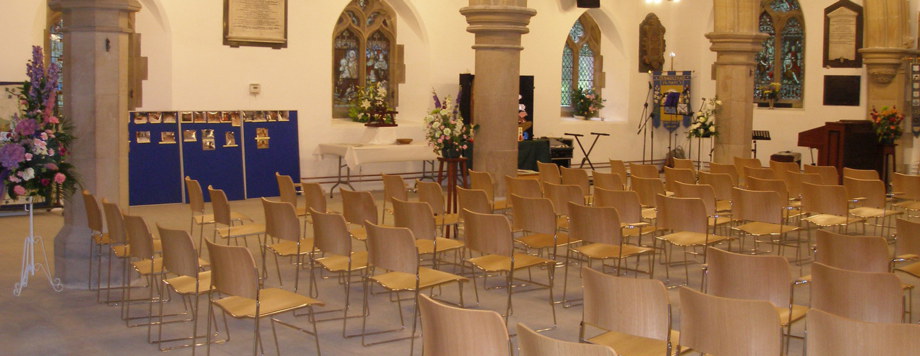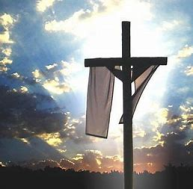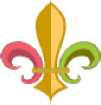
The Nave
Until the beginning of the 19th century, the Nave of Penwortham Church was narrow and low.with a gallery across the west end. In 1822 a new gallery, containing pews which were ‘sold’ to pay for the alterations, was installed along the north wall, joining the existing gallery at the west end. At the same time, the level of the roof was raised, four windows were added at a higher level on each side, and the roof parapets crenellated. The marks of these two roof levels can be seen on the wall of the Tower facing the Nave as two diagonal lines on either side of the present Organ.
The historian Baines, writing in 1836, describes the Church as narrow and gloomy - it had as far as we know no side aisles. (Although Baines says it had one, there is more substantial evidence against this view. Over the Chancel Arch was a decrepit painting of the Royal Arms. The Chancel Arch seems to have been no more than an opening sixteen feet across and eight feet high, with the north gallery nearly halfway across it.
The body of the Church measured 27 feet by 61 feet; about three fifths of the area was covered by galleries: small wonder, then, that it was called gloomy. The Font was under the west gallery, immediately south of the door to the Tower.
Opposite the north Gallery, and about ten feet into the Nave from the Chancel Arch, stood the tiered arrangement of (three-decker) clerk’s desk, reader’s desk, and pulpit, with the latter highest and hard against the south wall.
By mid-century the rebuilt Nave was found to be too small, and plans prepared by Paley of Lancaster were agreed on as the basis for rebuilding the Nave in its present form.
Two other plans were considered. One, inoffensive but rather weak, involved putting the Nave and two aisles
under one roof in which a few gable former windows replaced the clerestory. In this design the aisles pews faced east.
The other plan did not involve building side aisles, it retained the old Nave and its galleries, inserting into the north wall a galleried transept slightly higher than the Nave. In contrast to the
mid Gothic of the Nave, and the three-decker pulpit, this transept was to be of the most aggressive Victorian Gothic. There was to eb a large rose window behind the gallery, trefoiled ridge
tiles of two sizes, and heavy geometric tracery in windows considerably larger than those in the rest of the Church.
Penwortham was spared this. The galleries were cut back almost to the Tower, The Font brought forward into the open Church, and the roof raised once again to permit a clerestory. Two new aisles
were built, to be filled with tiered pews facing into the Nave. The old ‘private’ pews from the north Gallery went into the north aisle, better spaced in order to allow their occupants to indulge in
what was then an innovation, to kneel. Children’s benches occupied the back of the Church in front of the Tower. The two canopied square box pews juxt inside the Chancel were not then
interfered with.
The rebuilt Nave was re-opened on 25th January, 1856
Space became a problem again in 1865. Not because every seat in the Church was regularly filled, although the Vicar wrote that the Sunday Afternoon (3 p.m.) service nearly filed the Church, rather that there were not enough Pews (private pews that is as opposed to free seats or Pews, which were called benches). To satisfy the property-holding desires of Penwortham’s increasing middle class. At a Vestry meeting later in the year, ratepayers showed more interest in a plan to revise the burial fees than in drawings displayed to illustrate the proposed enlargement of the Church. In retrospect, this was fortunate, for the architect proposed to truncate the mediaeval Chancel in order to accomplish the enlargement. By that time, as the architect’s plan shows the west gallery had been cut back to its present position, a vestry had been added and the two box Pews in the Chancel replaced by the present rear choir stalls. The Vestry, an afterthought to the 1855-6 alterations, had soon to be rebuilt owing to a fire. An organ, by Hill had been installed shortly after the rebuilding.
Repairs of violoncello strings cost 2s 0d in 1855; in 1856 ringers and singers were paid for their services at the re-opening of the Church, but in 1857 a new item appears in the accounts, that of the organist’s salary - and violoncello strings were a burden no more.
The idea of enlargement was well into the background in 1884 when parishioners were content to reopen their Church after thorough cleaning of the stonework, improvements to Seward’s heating apparatus (which dated from 1865-6), and laying Minton’s tiles on the Nave and Chancel floors.
New Vestries, by Leach, Rhodes, and Walker of Manchester, were dedicated by the Bishop of Blackburn in 1956.
In 1959 a new organ by Jardines of Manchester was installed in the west gallery and in 1964 the Font was moved a few feet north and west to the centre of the area formerly occupied by the choir stalls.
The Fire
On Tuesday, January 6th, 1857 workmen were making some repairs to the Vestry next to the Tower. They lit a fire in the heating boiler which was in the cellar beneath. At 4 pm they left, with the fire still smouldering - safely, they thought - in the boiler.
However, during the night the Vestry was set on fire, either because the boiler flue had become too hot, or because wood shavings had been allowed to fall on to the boiler and had ignited. Early the following morning, a gamekeeper on his rounds discovered the Vestry to be totally burnt out.
Although the Vestry door had been burnt down, and the stone arch above it cracked by the heat, there was only slight damage in the rest of the Church, and that damage was confined to the organ in the west gallery. Inside the Vestry, everything was destroyed including a large oak chest containing documents, maps and registers.
Later on in the year, the Churchwardens rebuilt and refurnished the Vestry, purchasing also - belatedly - a fire proof safe. The total cost of the replacements and rebuilding was £46.
Fonts
Nothing is known about the font that existed in Penwortham Church before the 17th century; presumably there was one.
A font inscribed “T.R. 1667”, given possibly by Thomas Robinson (Vicar 1653-4), stood in the church until the 19th century (see note 5). In the 18th century, this font was superseded by a more grandiose marble font, inscribed:
H.Fleetwood, huius sitis necnon Ecclesiae Patronus (attamen indignus) D.D.D.Q 1725
That is
H Fleetwood of this place and also Patron of this Church (although unworthy) gave and dedicated this gift 1725
The present octagonal Caen stone font in the decorated style was given by a Churchwarden, Mr Norris of Howick House, at the end of 1856 (see Note 6). He asked if he might have the old (1667) font as a garden flower vase.
By about 1870, the Fleetwood (1725) font had found its way into the cellar of the Old Chapel at Longton, where it was found by the incumbent, The Rev’d C Astbury. He placed it in the old Chapel from which it was transferred to the present Church when that was built in 1886.
The old (1667) font appeared at the auction of the property of Mr. Norris in 1872, but no one would buy it. The auctioneer therefore took it to his house at Preston and on his death it came into the possession of a local antiquarian, Mr. T.H. Myers of Ashton-on-Ribble, who restored it to Penwortham Church in 1906.
Armour
When a knight died it was the tradition that some of his armour be hung in the Church at his burial. Until recently the two morions (helmets) and surcoat of John Fleetwood did indeed hang high up in the Chancel of Penwortham Church; now they are kept in a glass case in the Nave (relocated to the Chancel in 2011). John Fleetwood of Penwortham and Calwich had a very active career: during his life he as M.P. For Staffordshire, Sheriff of Staffordshire, Guild Burgess of Preston, and Sheriff of Lancashire; he was buried at Penwortham in 1590. One of the helmets has a beaver (visor) and a crest. This crest is that of Fleetwood, a wolf statant regardant. This helmet, gilded, would have been used on ceremonial occasions.
The leather surcoat, worn over the armour to protect the wearer from the sun, is emblazoned with the arms of Fleetwood: Per pale nebuly azure and or six martlets countercharged
The crest and shield may be seen more clearly on the dexter side of the achievement in the south west Chancel window and on the organ case.
Civil War
During the Battle of Ribbleton Moor, in 1648, Penwortham’s tower may have been used for reconnaissance, and seems to have been fired on, Large stone cannon balls were found in the Churchyard and they are kept in the glass display case in the Nave (relocated to the Chancel in 2011).
Note. Later research regarding the cannonballs reveals that they are more likely to be Roman ballista bolts which reinforces the view that there was a Roman presence in Penwortham.
Windows in the Aisles
These, without exception, are memorial windows, put in 1876-1901. In them the subject of the window is usually related to the profession or activity of the deceased. Thus a priest-headmaster gets the apostles Peter and Paul, and a Guardian of the Poor is remembered by the Good Samaritan. A lady Church worker is remembered in the women of the New Testament, and a Founder of Hutton School by a window on the subject of “Suffer the little children to come unto me”.
North Aisle, east end.
Robert Ascroft d. 1876
At the top of the window
“ Thine alms have gone up for a memorial before God”
In the left hand compartment, almsgiving is illustrated, and in the right, the Good Samaritan. There is a brass plaque beneath the window. Besides being Town Clerk of Preston 1852-75,
this gentleman was also Chairman of the Preston Union Guardians of the Poor 1859-66.
North Wall, east of centre
John Walmsley d. 1896
Signed ”Sewards of Lancaster 1897”, this window was subscribed for by his workpeople and is just behind the pew he used to occupy.
South Aisle, east end
John Cooper, bur 1888
At the top of the window:
“ Do justly, love mercy, walk humbly before God”
The three compartments have female figures represented “Fides”, “Spes” and “Caritas”: Faith, Hope and Charity. John Cooper lived at “The Oaks” and his funeral was the occasion for a
2,000 word sermon reprinted in the magazine.
South Wall, east
Christopher Walton, fl. 16th Century
Christopher Walton gave the benefaction that formed the basis for Hutton School. The window, by Cox and Buckley of London, was given by a descendant in 1891. At the top of the window is
the Achievement of Walton, and the glass below illustrates:
“Suffer the little children to come unto me”.
South wall, centre
Mary Rawstorne d. 1900
Three compartments illustrate famous women of the New Testament. At the centre is the Virgin Mary. On the left the text “She hath done what she could” adorns the picture of Mary of
Bethany, who is seen holding the phial from which she anointed Jesus (Mk 14). On the right is Dorcas, the seamstress, “Full of good works and almsgiving” (Ac 9). A brass on the sill records the
dedication of the window in 1901.
South aisle, west end
The Rev’d B.C Huntley, bur 1890
B.C Huntley was Headmaster of Hutton School until his early death. The window shows “St. Peter” (left) and “St. Paul” (right), At the top of the window is a quotation from the Prayer of the Church in the Book of Common Prayer (1662):
“We bless they holy name for all the servants departed this life in thy faith and fear beseeching thee to give us grace so to follow their good examples that with them we may be partakers of thy heavenly kingdom”.
Monuments in the Nave and Aisles
North wall, east to west
Revd. William Loxam, d. 1809
He was a Minister of Longton. The memorial caries the Achievement of Loxam and is by S. and T. Franceys of Liverpool.
The families of Dewhurst, Noble and Ascroft from 1772
East wall, north to south
Christiana Ascroft, d. 1897; William Ascroft, d. 1916
Elizabeth Rawstorne, d. 1840
Ralph Holmes, d. 1912
Revd. W.E.Rawstorne, d. 1907
He was incumbent of Penwortham 1858-88
Lawrence Rawstorne, d. 1803
Tablet by Webster of Kendal
South wall, east to west
Elizabeth G. A. Rawstorne, d 1823
The monument, again by Webster of Kendal, carries two shields, firstly of Rawstorne and secondly a unicorn between three hands.
John Horrocks M.P., D 1804
Well known cotton magnate, related to J. Horrocks, the astronomer. The monument was paid for by his nephew and executed by T. Marsh of London 1863.




